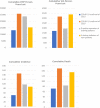Impact of COVID-19 Response on the HIV Epidemic in Men Who Have Sex With Men in San Francisco County: The Importance of Rapid Return to Normalcy
- PMID: 36728397
- PMCID: PMC9988211
- DOI: 10.1097/QAI.0000000000003156
Impact of COVID-19 Response on the HIV Epidemic in Men Who Have Sex With Men in San Francisco County: The Importance of Rapid Return to Normalcy
Abstract
Background: In response to the COVID-19 pandemic, San Francisco County (SFC) had to shift many nonemergency health care resources to COVID-19, reducing HIV control resources. We sought to quantify COVID-19 effects on HIV burden among men who have sex with men (MSM) as SFC returns to pre-COVID service levels and progresses toward the Ending the HIV Epidemic (EHE) goals.
Setting: Microsimulation model of MSM in SFC tracking HIV progression and treatment.
Methods: Scenario analysis where services affected by COVID-19 [testing, care engagement, pre-exposure prophylaxis (PrEP) uptake, and retention] return to pre-COVID levels by the end of 2022 or 2025, compared against a counterfactual where COVID-19 changes never occurred. We also examined scenarios where resources are prioritized to reach new patients or retain of existing patients from 2023 to 2025 before all services return to pre-COVID levels.
Results: The annual number of MSM prescribed PrEP, newly acquired HIV, newly diagnosed, and achieving viral load suppression (VLS) rebound quickly after HIV care returns to pre-COVID levels. However, COVID-19 service disruptions result in measurable reductions in cumulative PrEP use, VLS person-years, incidence, and an increase in deaths over the 2020-2035 period. The burden is statistically significantly larger if these effects end in 2025 instead of 2022. Prioritizing HIV care/prevention initiation over retention results in more person-years of PrEP but less VLS person-years and more deaths, influencing EHE PrEP outcomes.
Conclusions: Earlier HIV care return to pre-COVID levels results in lower cumulative HIV burdens. Resource prioritization decisions may differentially affect different EHE goals.
Copyright © 2023 The Author(s). Published by Wolters Kluwer Health, Inc.
Conflict of interest statement
The authors have no conflicts of interest to disclose.
Figures
References
-
- Centers for Disease Control and Prevention. COVID Data Tracker; 2022. Available at: https://covid.cdc.gov/covid-data-tracker/#datatracker-home. Accessed July 7, 2022.
-
- Iuliano AD, Brunkard JM, Boehmer TK, et al. . Trends in disease severity and health care utilization during the early Omicron variant period compared with previous SARS-CoV-2 high transmission periods—United States, December 2020–January 2022. MMWR Morb Mortal Wkly Rep. 2022;71:146–152. - PMC - PubMed
-
- Rio Cdel, Malani PN. COVID-19 in 2022—the beginning of the end or the end of the beginning? JAMA. 2022;327:2389–2390. - PubMed
-
- del Amo J, Diaz A, Polo R. The impact of coronavirus disease 2019 on people with HIV. Curr Opin Infect Dis. 2022;35:9–14. - PubMed



